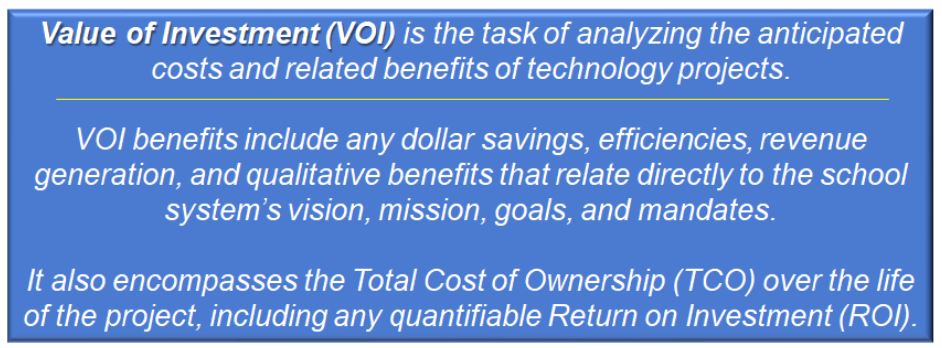If EdTech leaders were in the business sector, purchasing decisions would be based on justification in money terms. Costs and benefits would be scrutinized before any money is spent. Investment decisions would be grounded in verifiable methods. But that’s not always the case for EdTech leaders.
We make far more impactful decisions focused on providing the best education for students. These decisions are more difficult to quantify. Think about how we measure student engagement or interest in STEM? How do we assess those types of benefits?
What about quantifying improvement in student skills related to problem-solving, collaboration,
communication, and confidence? How do we prove students are learning in these areas? That adds an additional level of intricacy because these measures are qualitative and are about behavior. These outcomes are usually reported in the context of the informant based on their observation and frame of reference.
Consider the complexities of digital equity and school transformation. What indicators do we use to demonstrate sustainability and supporting education programs? Costs can be estimated, but measuring benefits are more difficult.
This year, primarily because of the additional funding, grant opportunities, and the increasing need to show value for technology purchases, there is rekindled interest in Value of Investment (VOI).

At first glance, VOI analysis looks daunting, but it’s just a process. CoSN, in a newly formed partnership with Verizon’s Innovative Learning Schools (VILS), is exploring the VOI process. EdTech leaders in the VILS program, with Digital Promise, are simplifying the process and using VOI to guide purchasing and sustainability planning decisions. Here are a few tips that we’ve learned so far.
- Determine the Total Cost of Ownership. Account for everything, initial purchases, and subscriptions, for both direct and indirect costs. This includes all anticipated project costs over the life of the project.
- Calculate any projected Return on Investment (ROI). Calculate anticipated costs saved. This may be savings in dollars, time, cost avoidance and revenue. Include efficiencies gained. Will annual budgets be reduced? Will productivity be improved? Will future costs be avoided?
- Measure Qualitative Benefits. List the strategic goals that will be positively affected by the proposed project.
- Assign a relative level of importance to help prioritize each technology investment. This is helpful if multiple projects are competing for funding.
- Identify the anticipated benefits aligned to the goals in measurable terms, if possible. These measures may include evidence of progress, estimated benefits, key performance indicators, specific action steps, metrics, or explanations of value statements,
- Estimate every line item of resources that will need to be purchased or sustained.
- Assign a relative level of importance to help prioritize each technology investment. This is helpful if multiple projects are competing for funding.
- Consider project risks. This is your best intrinsic guess about the probability of success for the proposed technology project, factoring in the scheduling, political climate, cost savings or avoidance, increased student equipment and achievement, safety, and security, along with any other factors.
Once the detailed VOI analysis work is done, you are ready to build your case for planning and purchasing technology projects. VOI is not always A plus B equals C. Defining how we quantify the VOI may be more about how we tell the story and use the results from the VOI analysis. Synthesize the information and give it your best shot!
Here are some ideas about how the VOI analysis can be used.
- Presentation to convince stakeholders to invest in the technology.
- Evaluation for the business office to determine the priority for funding projects.
- Help decide which project offers the best cost / benefit value in the scope of the total school system’s budget.
- Documentation to help articulate the purpose of the project at a more detailed level.
- Understand what it will take to sustain the project in the future when the time comes to refresh and support the ongoing costs.
As EdTech leaders, VOI is one way we can show technology investments are impactful, effective, and worth the value of investment!
Learn more in CoSN’s IT Project Management Course for K12 School System Technology Leaders https://www.cosn.org/education-events/online-courses/#IT
And CoSN’s Webinars: https://www.cosn.org/education-events/event-calendar/
Frankie Jackson Trusted Technology Thought Partner


